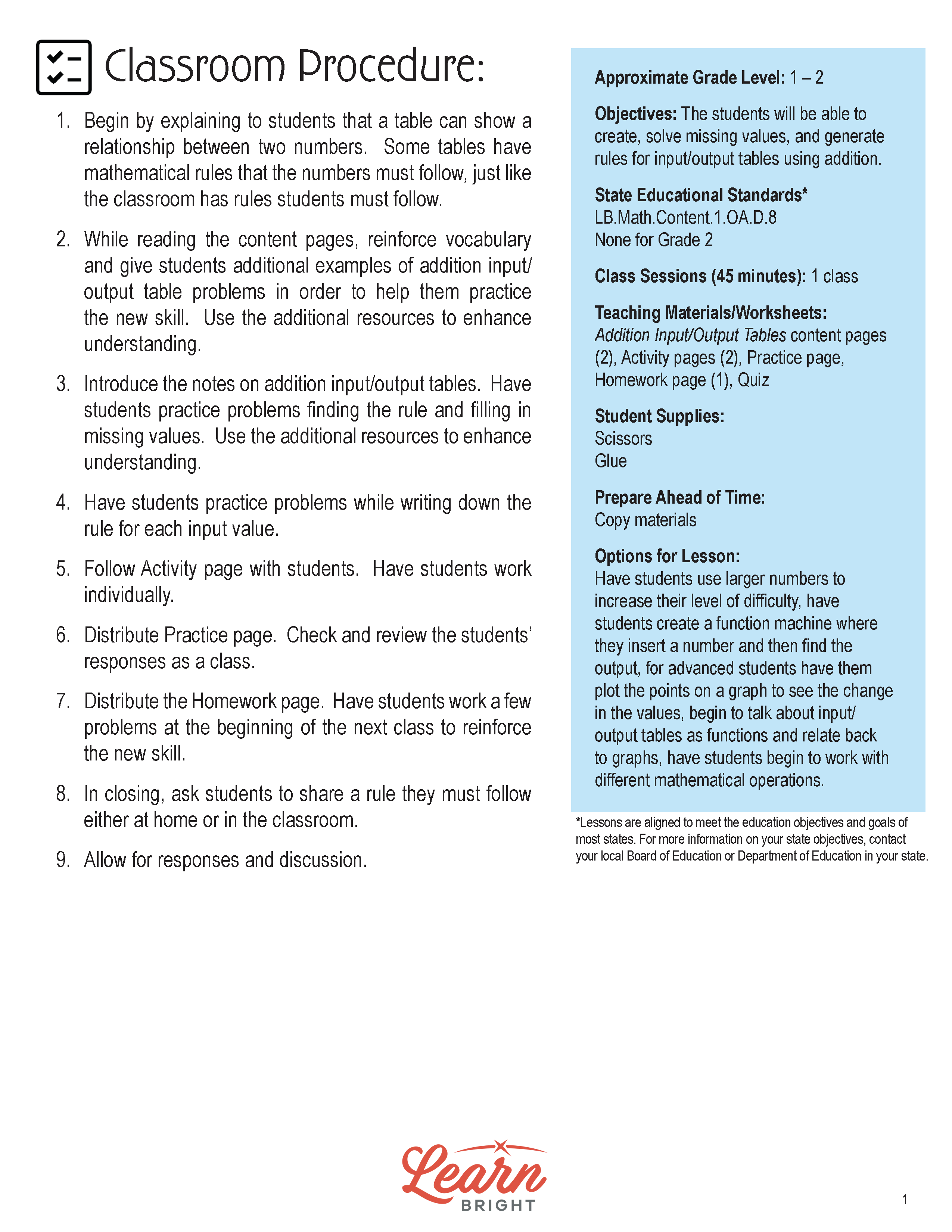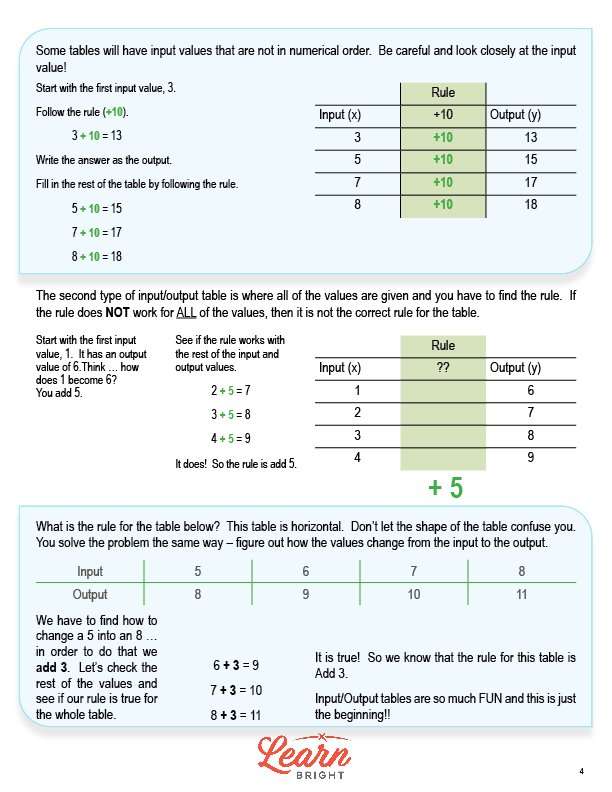Description
What our Addition Input/Output Tables lesson plan includes
Lesson Objectives and Overview: Addition Input/Output Tables lesson plan presents input/output tables as a way to show the relationship between two numbers. The lesson defines input, output, and rules at the beginning of the lesson. The lesson emphasizes finding a rule that works with every value that is part of the table and includes examples. At the end of the lesson, students will be able to create, solve missing values, and generate rules for input/output tables using addition. This lesson is for students in 1st grade and 2nd grade.
Classroom Procedure
Every lesson plan provides you with a classroom procedure page that outlines a step-by-step guide to follow. You do not have to follow the guide exactly. The guide helps you organize the lesson and details when to hand out worksheets. It also lists information in the blue box that you might find useful. You will find the lesson objectives, state standards, and number of class sessions the lesson should take to complete in this area. In addition, it describes the supplies you will need as well as what and how you need to prepare beforehand. The supplies you will need for this lesson are scissors and glue. To prepare for this lesson ahead of time, you can gather the supplies and copy the handouts.
Options for Lesson
Included with this lesson is an “Options for Lesson” section that lists a number of suggestions for activities to add to the lesson or substitutions for the ones already in the lesson. If you want to increase the difficulty for your students, you can have them use larger numbers. You can also have students create a function machine where they insert a number and find the output. If you have more advanced students, you can have them plot points on a graph to see a visual representation of the change in values. You can also start talking about input/output tables as functions, relating them back to graphs. Finally, you can have students work with different mathematical operations.
Teacher Notes
The teacher notes page includes lines that you can use to add your own notes as you’re preparing for this lesson.
ADDITION INPUT/OUTPUT TABLES LESSON PLAN CONTENT PAGES
Addition Input/Output Tables
The Addition Input/Output Tables lesson plan includes two content pages. The lesson begins by explaining that input/output tables show the relationship between two sets of numbers, which always follow a rule. Sometimes these tables can be very complex (and people use them at their jobs!) but some of them are quite simple and represent a single mathematical operation. When working with input/output tables, there are two main types of problems: finding missing values using the rule and figuring out the rule.
The lesson then goes over some basic lesson vocabulary. Input/output tables are tables with two sets of numbers. They can be horizontal or vertical and we sometimes also call them function tables. An input is the number that we start with to follow the rule. You always start with the input, which we also call the x value. An output is the answer or end number once the rule is applied to the input. We also call outputs the y value. Finally, the rule is the operation(s) that we have to follow to find the correct output for the input values.
Next, the lesson shows an example table. For this input/output table, the first input value is 0. The rule is +3. When we follow the rule, we get 0 + 3 = 3. 3 is the output. The next input value is 1, and when we follow the rule (1 + 3) we get 4 as the output. We can then continue the pattern for all of the input values. For some tables, the input values may not be in numerical order. This is why it’s so important to pay attention to the input values!
The lesson then goes over the second type of input/output table. For these, you’re given all of the values and you have to find the rule. If the rule does not work for every value, then it’s not the correct rule for that table. The lesson shows an example. We start with the first set of values: 1 as the input and 6 as the output. To go from 1 to 6, we need to add 5, so +5 might be the rule. Next, we test that rule with all of the other values. Because the rule works for the rest of the values, we know that the rule is +5.
The lesson includes additional examples for both types of tables to help solidify students’ understanding of the lesson concepts.
ADDITION INPUT/OUTPUT TABLES LESSON PLAN WORKSHEETS
The Addition Input/Output Tables lesson plan includes three worksheets: an activity worksheet, a practice worksheet, a homework assignment, and a quiz. You can refer to the guide on the classroom procedure page to determine when to hand out each worksheet.
INPUT/OUTPUT RULES ACTIVITY WORKSHEET
For the activity worksheet, students will cut out the rules (such as “add 4” and “add 2”) and glue them next to the correct table.
FIND THE RULE PRACTICE WORKSHEET
For the practice worksheet, students will look at the input/output tables and find the rule for each. They will then fill in each table.
ADDITION INPUT/OUTPUT TABLES HOMEWORK ASSIGNMENT
The homework assignment asks students to create four of their own input/output tables suing their own rules of addition.
QUIZ
This lesson also includes a quiz that you can use to test students’ understanding of the lesson material. For the quiz, students will fill in the blanks using the provided vocabulary terms.
Worksheet Answer Keys
This lesson plan includes answer keys for the activity worksheet, the practice worksheet, and the quiz. If you choose to administer the lesson pages to your students via PDF, you will need to save a new file that omits these pages. Otherwise, you can simply print out the applicable pages and keep these as reference for yourself when grading assignments.









